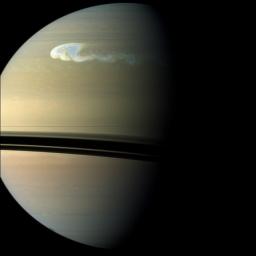Spotting Saturn’s Northern Storm
Caption:
NASA's Cassini spacecraft captures a composite near-true-color view of the huge storm churning through the atmosphere in Saturn's northern hemisphere.
This storm is the largest and most intense observed on Saturn by NASA's Voyager or Cassini spacecraft. The storm is still active. As scientists have tracked this storm over several months, they have found it covers 500 times the area of the biggest of the southern hemisphere storms observed earlier in the Cassini mission (see
PIA06197
and
PIA12576
). The shadow cast by Saturn's rings has a strong seasonal effect, and it is possible that the switch to powerful storms now being located in the northern hemisphere is related to the change of seasons after the planet's August 2009 equinox.
In an image captured Dec. 5, 2010, scientists saw a small white spot with a size of about 800 miles (1,300 kilometers) north-to-south and 1,600 miles (2,500 kilometers) east-to-west. In this view, taken on Dec. 24, 2010, the storm has grown to a north-to-south, or latitudinal, extent of about 6,000 miles (10,000 kilometers) three weeks after the storm started. The main part of the storm has an east-to-west, or longitudinal, extent of about 11,000 miles (17,000 kilometers) in this view. Other images taken at the same time show the tail extending almost one-third of the way around the planet - a distance of 62,000 miles (100,000 kilometers).
See
PIA12825
for a false-color view taken about two months after this view, with the storm's tail encircling the planet and the latitudinal extent swollen to almost 9,000 miles (15,000 kilometers).
Periodic, huge storms called Great White Spots have been observed in previous Saturnian years (each of which is about 30 Earth years), usually appearing in late northern summer. Saturn is now experiencing early northern spring, so this storm, if it is a Great White Spot, is happening earlier than usual. This storm is about as large as the largest of the Great White Spots, which also encircled the planet but had latitudinal sizes ranging up to 12,000 miles (20,000 kilometers). The Voyager and Cassini spacecraft were not at Saturn for previous Great White Spot appearances.
This view looks toward the southern, unilluminated side of the rings from just below the ring plane.
Images taken using red, green and blue spectral filters are usually combined to create a natural color view. Because a visible red light image was not available, an image taken using a spectral filter sensitive to wavelengths of near-infrared light centered at 752 nanometers was used in place of red. So the color is close to natural color, but is not exact.
The images were taken with the Cassini spacecraft wide-angle camera. The view was obtained at a distance of approximately 1.2 million miles (1.9 million kilometers) from Saturn and at a sun-Saturn-spacecraft, or phase, angle of 71 degrees. Because the three images were of different resolutions, they were all projected to the same scale of about 89 miles (143 kilometers) per pixel.
Background Info:
The Cassini-Huygens mission is a cooperative project of NASA, the European Space Agency and the Italian Space Agency. The Jet Propulsion Laboratory, a division of the California Institute of Technology in Pasadena, manages the Cassini-Huygens mission for NASA's Science Mission Directorate, Washington. The Cassini orbiter and its two onboard cameras were designed, developed and assembled at JPL. The imaging team is based at the Space Science Institute in Boulder, Colo.
For more information about the Cassini-Huygens mission visit
http://saturn.jpl.nasa.gov
and
http://www.nasa.gov/cassini
. The Cassini imaging team homepage is at
http://ciclops.org
.
Cataloging Keywords:
| Name |
Value |
Additional Values |
| Target |
Saturn |
Saturn Rings |
| System |
Saturn |
|
| Target Type |
Planet |
Ring |
| Mission |
Cassini-Huygens |
Voyager |
| Instrument Host |
Cassini Orbiter |
|
| Host Type |
Orbiter |
Flyby Spacecraft |
| Instrument |
Imaging Science Subsystem (ISS) |
|
| Detector |
Wide Angle Camera |
|
| Extra Keywords |
Atmosphere, Color, Infrared, Shadow, Storm, Visual, Wave |
| Acquisition Date |
|
| Release Date |
2011-07-06 |
| Date in Caption |
2010-12-05 |
2010-12-24 |
| Image Credit |
NASA/JPL-Caltech/Space Science Institute |
| Source |
photojournal.jpl.nasa.gov/catalog/PIA12824 |
| Identifier |
PIA12824 |

 Planetary Data System
Planetary Data System
